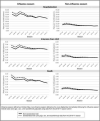Trends in Influenza Vaccine Uptake and Severe Influenza-Related Outcomes at Kaiser Permanente Southern California, 2007-2017
- PMID: 33970069
- PMCID: PMC8817914
- DOI: 10.7812/TPP/20.154
Trends in Influenza Vaccine Uptake and Severe Influenza-Related Outcomes at Kaiser Permanente Southern California, 2007-2017
Abstract
Introduction: Major efforts to increase influenza vaccine uptake among Kaiser Permanente Southern California (KPSC) members have been undertaken in recent years. However, whether these improvements translate to a decline in severe influenza-related outcomes has not been examined. We aimed to understand the impact of the influenza vaccination program at KPSC by examining influenza vaccine uptake and 3 severe influenza-related outcomes.
Methods: We conducted an ecologic trend analysis to understand influenza vaccine uptake and influenza-related hospitalization, intensive care unit (ICU) admission, and mortality for each influenza season (2007-2017). The same cohort was followed from the influenza season to the noninfluenza season immediately afterward while using the noninfluenza season as the comparison group. We also assessed the within-season correlation between influenza vaccine uptake and influenza-related outcomes.
Results: Influenza vaccine uptake rose from 23.9% to 45.5%, and all 3 influenza-related outcome rates declined (hospitalization: 35.4-26.8/10,000 patients; ICU: 5.9-5.2/10,000 patients; and mortality: 3.4-2.3/10,000 patients). Influenza vaccine uptake was negatively correlated with hospitalization (-0.32, p < 0.001) and mortality (-0.29, p = 0.001). However, once we adjusted for the noninfluenza season, the results of the correlation analysis were no longer statistically significant.
Conclusion: Although we could not establish a statistically significant inverse relationship between influenza vaccination and severe influenza-related outcomes over the study period, our findings indicate an overall decline in influenza-related outcomes over the study period, suggesting improvements in both preventive and acute care quality at KPSC.
Copyright © 2021 The Permanente Press. All rights reserved.
Conflict of interest statement
Figures


Similar articles
-
Comparative Effectiveness of Cell-Based Versus Egg-Based Influenza Vaccines in Prevention of Influenza Hospitalization During the 2022-2023 Season Among Adults 18-64 Years.Influenza Other Respir Viruses. 2024 Dec;18(12):e70025. doi: 10.1111/irv.70025. Influenza Other Respir Viruses. 2024. PMID: 39696975 Free PMC article.
-
Safety of Influenza Vaccination Administered During Hospitalization.Mayo Clin Proc. 2019 Mar;94(3):397-407. doi: 10.1016/j.mayocp.2018.11.024. Epub 2019 Jan 8. Mayo Clin Proc. 2019. PMID: 30635116
-
Influenza Vaccine Effectiveness in Preventing Severe Outcomes in Patients Hospitalized with Laboratory-Confirmed Influenza during the 2017-2018 Season. A Retrospective Cohort Study in Catalonia (Spain).Viruses. 2021 Jul 27;13(8):1465. doi: 10.3390/v13081465. Viruses. 2021. PMID: 34452337 Free PMC article.
-
Understanding the unique characteristics of seasonal influenza illness to improve vaccine uptake in the US.Vaccine. 2018 Nov 19;36(48):7276-7285. doi: 10.1016/j.vaccine.2018.10.027. Epub 2018 Oct 23. Vaccine. 2018. PMID: 30366802 Review.
-
Impact of influenza vaccination on healthcare utilization - A systematic review.Vaccine. 2019 May 27;37(24):3179-3189. doi: 10.1016/j.vaccine.2019.04.051. Epub 2019 Apr 30. Vaccine. 2019. PMID: 31047677
Cited by
-
Influenza Vaccination Uptake and Associated Factors Among Adults With and Without Human Immunodeficiency Virus in a Large, Integrated Healthcare System.Clin Infect Dis. 2023 Jul 5;77(1):56-63. doi: 10.1093/cid/ciad106. Clin Infect Dis. 2023. PMID: 36857440 Free PMC article.
References
-
- World Health Organization . Evaluation of influenza vaccine effectiveness: A guide to the design and interpretation of observational studies. Geneva: World Health Organization; 2017. Report No.: 9241512121.
MeSH terms
Substances
LinkOut - more resources
Full Text Sources
Medical

